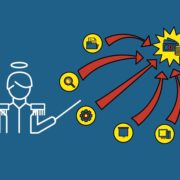The Difference Between Blended Learning and E-Learning
As schools and colleges around the world have been forced to transition to distance learning in response to the pandemic, a variety of terms connected to it are also being increasingly used. Distance learning, e-learning, blended learning, online learning – these are all different terms to describe ways in which you can pursue education remotely.
The terms Blended learning and E-learning are often used interchangeably, however there are significant differences in the strategies and teaching techniques of these two approaches of digital education.
It’s important for educators and school administrators to carefully weigh the pros and cons of blended learning and e-learning, so they can choose the system that best fits their needs and the learning experience that they want to provide to their students.
Let us explore the major ways in which blended learning and e-learning differ.
What is E-Learning?
E-learning refers to a learning system based on formalised teaching, conducted via electronic media, typically on the internet. While teaching can be based in a classroom or an online setting, the use of computers and the Internet forms the major component of E-learning.
What is Blended Learning?
Blended learning on the other hand is a combination of distance learning and traditional face-to-face learning in a classroom. It is sometimes also referred to as hybrid learning. A blended learning program may include monthly face-to-face training days, weekly assignments, and daily or frequently peer-to-peer discussions over a digital platform.
Differences Between Blended Learning and E Learning
- Online vs. Everywhere
E-learning courses take place online only, while Blended learning uses the internet in a supporting role.
The major benefit of E-learning is that it is completely independent of time and place. In most courses, participants can choose their own pace of learning and convenient learning time.
Blended learning supports various learning styles. Unlike e-learning, which tries to fit every participant into the same mould, blended learning incorporates different learning styles and preferences so that the participants can optimally use their preferred learning channels.
- Immersive vs. One directional
The 70/20/10 model of learning and development states that only 10% of learning can be achieved in formal classroom setting. The remaining 20% and 70% are derived from interaction with peers and challenging assignments respectively.
The problem with e-learning modules is that they are quite isolated from the learner’s reality. Through online learning materials students can somehow memorise theoretical concepts, but often these learnings lack context. And therefore, does not really stick.
Blended learning on the other hand, is immersive and interactive in nature, and subjects the participants to a lot of stimulating exercises, encouraging them to apply what they’ve learnt into everyday situations. That’s what accounts for 70% of long-term professional development.
Thus, blended learning is usually more effective than e learning, and sets participants up for success.
The ideal use cases for e learning is short-term, tactical training courses. While blended learning is best suited for long-lasting, organisational learning programs.
Educational platforms such as Learning Cloud will be able to help you choose which educational model might work for you.
















